Constantinople, Hippodrome
Q387548Hippodrome of Constantinople: the ancient circus for chariot-racing, one of the main monuments in Constantinople.
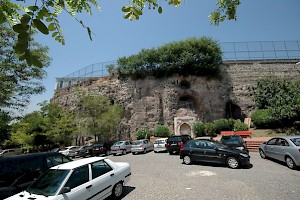
The Hippodrome of Constantinople was the place for horse races. It still survives as a park in which the traces of the old race course are clearly visible and a ruin. Constructed in 203, during the reign of the emperor Septimius Severus, and expanded after 324 by Constantine the Great, it was about 130 meters wide and 450 meters long. The hippodrome could accommodate about 40,000-50,000 people. The place, which is more or less northeast-southwest in orientation, is in Turkish called Sultanahmet Meydanı or At Meydanı ("Horse Square").
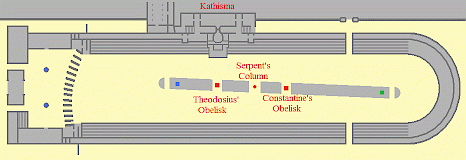
Entering from the northeast, the chariots several times had to round the spina, the longitudional barrier in the center of the circus, which was decorated with several monuments. The oldest of these may have been the so-called Obelisk of Constantine Porphyrogenitus, situated in the center of the spina. Constantine added the Serpents' Column, a bit to the northeast; the Obelisk of Theodosius was in 390 added by Theodosius I, a bit more to the northeast, in front of the imperial lodge (kathisma).
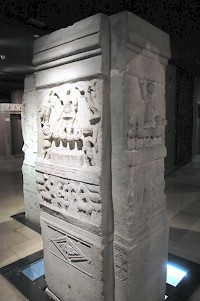
The two Porphyrius monuments were the pedestals of statues that were erected to commemorate a charioteer who was active in the first quarter of the sixth century. They were made from marble and closely resemble each other; still, they were commissioned by fans of two opposing stables, the "Blues" (Veneti) and the "Greens" (Prasinoi), and were not erected at the same time. Both bases are adorned with reliefs and epigrams that praise Porphyrius, who must, after the first statue had been erected, have switched to the opposing faction. Other texts include the shouts of the audience ("You can do it, fortune of the Greens!") and the names of ten of the horses: Nicopolemos, Radiatos, Pyrrhos, Euthynicos, Halieus, Anthypatos, Cynagos, Pelorios, Aristides, and Palaestinarches.
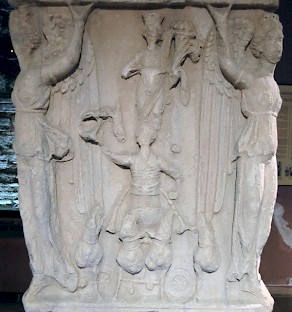
The main relief shows Porphyrius, standing in his quadriga (chariot drawn by four horses), holding a wreath in one hand and the reins or a palm branch in the other. On the other sides, we can see his fans, an emperor (probably Anastasius I) watching the spectacle, musicians, Nikes, and Tyche, the protector-goddess of Constantinople, with a cornucopia. Reportedly, there five other monuments of Porphyrius on the spina.
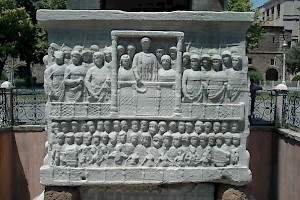
The fans of the Greens and Blues could be very enthusiastic. In January 532, they started to fight - this was nothing new - and the emperor Justinian intervened: the ringleaders were arrested and executed. Next day, the two factions unitedly turned against the emperor, shouting "Nika! Nika" (win!). The angry mob stormed the prison, liberated several captured hooligans, and continued to loot the palace and several buildings in the neighborhood. The churches of the Divine Wisdom and Divine Peace were destroyed. In the end, Justinian ordered his mercenaries to attack the looters. About 30,000 Constantinopoliteans were massacred, and that was the bloody end of the Nika riots.
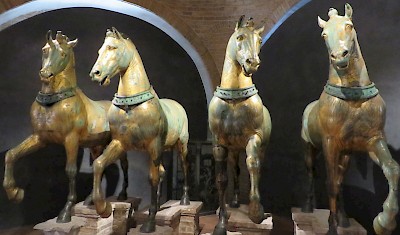
On the eastern side was the kathisma, the emperor's lodge, more or less on the place of the court of today's Mosque of Sultan Ahmet. It had a direct connection with the palace itself.
The emperor's lodge was decorated with four gilded bronze horses that had been made by the Greek artist Lysippus, long time ago, in the mid-fourth century BCE. Together with the gilded bronze slabs that decorated the Obelisk of Constantine Porphyrogenitus, they were stolen when the Crusaders captured and looted Constantinople in 1204. They are now in Venice, in the Basilica of San Marco.
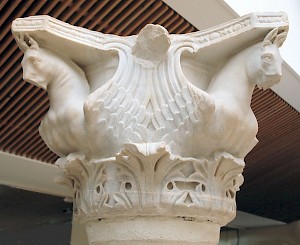
The last photo shows a capital, which belonged to a column of the kathisma and was made of white marble. Four winged horses carry the roof of the imperial lodge. It is extremely fine artwork, and was made in the first half of the sixth century.
Parts of the hippodrome have been excavated and investigated, but only the southernmost part is visible (first photo).
Literature
- James Grout, "The sphendone"
- James Grout, "Porphyrius the Charioteer"